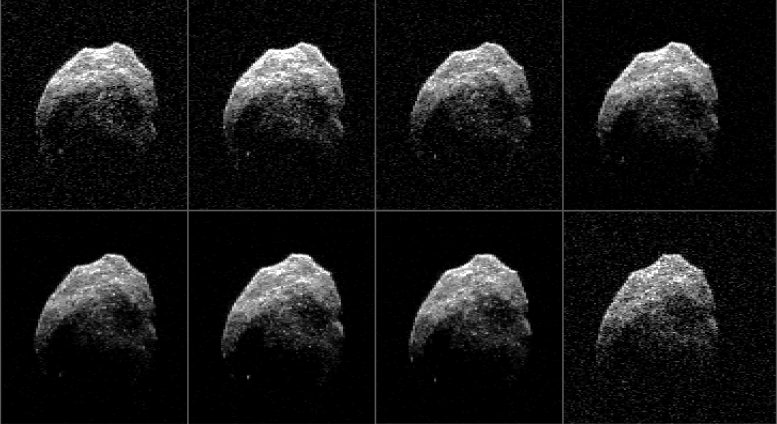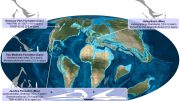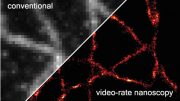
Asteroid 2015 TB145 is depicted in eight individual radar images collected on October 31, 2015 between 5:55 a.m. PDT (8:55 a.m. EDT) and 6:08 a.m. PDT (9:08 a.m. EDT). At the time the radar images were taken, the asteroid was between 440,000 miles (710,000 kilometers) and about 430,000 miles (690,000 kilometers) distant. Asteroid 2015 TB145 safely flew past Earth on October 31, at 10:00 a.m. PDT (1 p.m. EDT) at about 1.3 lunar distances (300,000 miles, 480,000 kilometers). Credit: NASA/JPL-Caltech/GSSR/NRAO/AUI/NSF
Astronomers captured new highest-resolution radar images of asteroid 2015 TB145 when it flew by Earth this past Halloween.
The highest-resolution radar images of asteroid 2015 TB145’s safe flyby of Earth have been processed. NASA scientists used giant, Earth-based radio telescopes to bounce radar signals off the asteroid as it flew past Earth on October 31 at 10 a.m. PDT (1 p.m. EDT) at about 1.3 lunar distances (300,000 miles, or 480,000 kilometers) from Earth. Asteroid 2015 TB145 is spherical in shape and approximately 2,000 feet (600 meters) in diameter.
“The radar images of asteroid 2015 TB145 show portions of the surface not seen previously and reveal pronounced concavities, bright spots that might be boulders, and other complex features that could be ridges,” said Lance Benner of NASA’s Jet Propulsion Laboratory in Pasadena, California, who leads NASA’s asteroid radar research program. “The images look distinctly different from the Arecibo radar images obtained on October 30 and are probably the result of seeing the asteroid from a different perspective in its three-hour rotation period.”
To obtain these highest-resolution radar images of the asteroid, scientists used the 230-foot (70-meter) DSS-14 antenna at Goldstone, California, to transmit high-power microwaves toward the asteroid. The signal bounced off the asteroid, and its radar echoes were received by the National Radio Astronomy Observatory’s 100-meter (330-foot) Green Bank Telescope in West Virginia. The radar images achieve a spatial resolution as fine as 13 feet (4 meters) per pixel.
The next time that asteroid 2015 TB145 will be in Earth’s neighborhood will be in September 2018, when it will make a distant pass at about 24 million miles (38 million kilometers), or about a quarter the distance between Earth and the sun.
Radar is a powerful technique for studying an asteroid’s size, shape, rotation, surface features, and surface roughness, and for improving the calculation of asteroid orbits. Radar measurements of asteroid distances and velocities often enable computation of asteroid orbits much further into the future than would be possible otherwise.
NASA places a high priority on tracking asteroids and protecting our home planet from them. In fact, the U.S. has the most robust and productive survey and detection program for discovering near-Earth objects (NEOs). To date, U.S. assets have discovered about 98 percent of known NEOs.









Be the first to comment on "Updated Radar Images Provide New Details on Asteroid 2015 TB145"